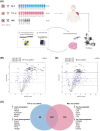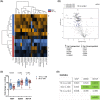NanoString technology distinguishes anti-TIF-1γ+ from anti-Mi-2+ dermatomyositis patients
- PMID: 34043263
- PMCID: PMC8412076
- DOI: 10.1111/bpa.12957
NanoString technology distinguishes anti-TIF-1γ+ from anti-Mi-2+ dermatomyositis patients
Erratum in
-
Corrigendum.Brain Pathol. 2022 Mar;32(2):e13053. doi: 10.1111/bpa.13053. Brain Pathol. 2022. PMID: 35213085 Free PMC article. No abstract available.
Abstract
Dermatomyositis (DM) is a systemic idiopathic inflammatory disease affecting skeletal muscle and skin, clinically characterized by symmetrical proximal muscle weakness and typical skin lesions. Recently, myositis-specific autoantibodies (MSA) became of utmost importance because they strongly correlate with distinct clinical manifestations and prognosis. Antibodies against transcription intermediary factor 1γ (TIF-1γ) are frequently associated with increased risk of malignancy, a specific cutaneous phenotype and limited response to therapy in adult DM patients. Anti-Mi-2 autoantibodies, in contrast, are typically associated with classic DM rashes, prominent skeletal muscle weakness, better therapeutic response and prognosis, and less frequently with cancer. Nevertheless, the sensitivity of autoantibody testing is only moderate, and alternative reliable methods for DM patient stratification and prediction of cancer risk are needed. To further investigate these clinically distinct DM subgroups, we herein analyzed 30 DM patients (n = 15 Mi-2+ and n = 15 TIF-1 γ+ ) and n = 8 non-disease controls (NDC). We demonstrate that the NanoString technology can be used as a very sensitive method to clearly differentiate these two clinically distinct DM subgroups. Using the nCounter PanCancer Immune Profiling Panel™, we identified a set of significantly dysregulated genes in anti-TIF-1γ+ patient muscle biopsies including VEGFA, DDX58, IFNB1, CCL5, IL12RB2, and CD84. Investigation of type I IFN-regulated transcripts revealed a striking type I interferon signature in anti-Mi-2+ patient biopsies. Our results help to stratify both subgroups and predict, which DM patients require an intensified diagnostic procedure and might have a poorer outcome. Potentially, this could also have implications for the therapeutic approach.
Keywords: Mi-2; NanoString; TIF-1γ; dermatomyositis; myositis-specific antibody; skeletal muscle.
© 2021 The Authors. Brain Pathology published by John Wiley & Sons Ltd on behalf of International Society of Neuropathology.
Conflict of interest statement
The authors report no disclosures relevant to the manuscript.
Figures



Similar articles
-
Distinctive cutaneous and systemic features associated with antitranscriptional intermediary factor-1γ antibodies in adults with dermatomyositis.J Am Acad Dermatol. 2015 Mar;72(3):449-55. doi: 10.1016/j.jaad.2014.12.009. Epub 2015 Jan 14. J Am Acad Dermatol. 2015. PMID: 25595720 Free PMC article.
-
Autoantibody to transcriptional intermediary factor-1β as a myositis-specific antibody: clinical correlation with clinically amyopathic dermatomyositis or dermatomyositis with mild myopathy.Br J Dermatol. 2019 Apr;180(4):881-887. doi: 10.1111/bjd.17098. Epub 2018 Oct 10. Br J Dermatol. 2019. PMID: 30120913
-
Dermatomyositis with anti-TIF-1γ antibodies as a presenting symptom of underlying triple-negative breast cancer: a case report.BMC Cancer. 2016 Aug 25;16(1):684. doi: 10.1186/s12885-016-2715-1. BMC Cancer. 2016. PMID: 27561848 Free PMC article.
-
Use of Anti-transcriptional Intermediary Factor-1 Gamma Autoantibody in Identifying Adult Dermatomyositis Patients with Cancer: A Systematic Review and Meta-analysis.Acta Derm Venereol. 2019 Mar 1;99(3):256-262. doi: 10.2340/00015555-3091. Acta Derm Venereol. 2019. PMID: 30460368
-
Cutaneous Manifestations in Dermatomyositis: Key Clinical and Serological Features-a Comprehensive Review.Clin Rev Allergy Immunol. 2016 Dec;51(3):293-302. doi: 10.1007/s12016-015-8496-5. Clin Rev Allergy Immunol. 2016. PMID: 26100618 Review.
Cited by
-
Research progress on the dermatomyositis specific autoantibodies and malignancy associated dermatomyositis.Zhong Nan Da Xue Xue Bao Yi Xue Ban. 2023 Dec 28;48(12):1890-1898. doi: 10.11817/j.issn.1672-7347.2023.220594. Zhong Nan Da Xue Xue Bao Yi Xue Ban. 2023. PMID: 38448383 Free PMC article. Chinese, English.
-
Recent data and developments in myositis.Brain Pathol. 2021 May;31(3):e12966. doi: 10.1111/bpa.12966. Brain Pathol. 2021. PMID: 34043261 Free PMC article. No abstract available.
-
Small duct and large duct type intrahepatic cholangiocarcinoma reveal distinct patterns of immune signatures.J Cancer Res Clin Oncol. 2024 Jul 22;150(7):357. doi: 10.1007/s00432-024-05888-y. J Cancer Res Clin Oncol. 2024. PMID: 39034327 Free PMC article.
-
CXCL1 and CXCL6 Are Potential Predictors for HCC Response to TACE.Curr Oncol. 2023 Mar 20;30(3):3516-3528. doi: 10.3390/curroncol30030267. Curr Oncol. 2023. PMID: 36975480 Free PMC article.
-
Complement and MHC patterns can provide the diagnostic framework for inflammatory neuromuscular diseases.Acta Neuropathol. 2024 Jan 12;147(1):15. doi: 10.1007/s00401-023-02669-8. Acta Neuropathol. 2024. PMID: 38214778 Free PMC article. Review.
References
-
- Mammen AL, Allenbach Y, Stenzel W, Benveniste O, ENMC 239th Workshop Study Group . 239th ENMC International Workshop: Classification of dermatomyositis, Amsterdam, the Netherlands, 14–16 December 2018. Neuromuscul Disord. 2020;30:70–92. - PubMed
-
- Sasaki H, Kohsaka H. Current diagnosis and treatment of polymyositis and dermatomyositis. Mod Rheumatol. 2018;28:913–21. - PubMed
-
- Hida A, Yamashita T, Hosono Y, Inoue M, Kaida K, Kadoya M, et al. Anti‐TIF1‐gamma antibody and cancer‐associated myositis: A clinicohistopathologic study. Neurology. 2016;87:299–308. - PubMed
Publication types
MeSH terms
Substances
LinkOut - more resources
Full Text Sources
Other Literature Sources
Medical
Miscellaneous

